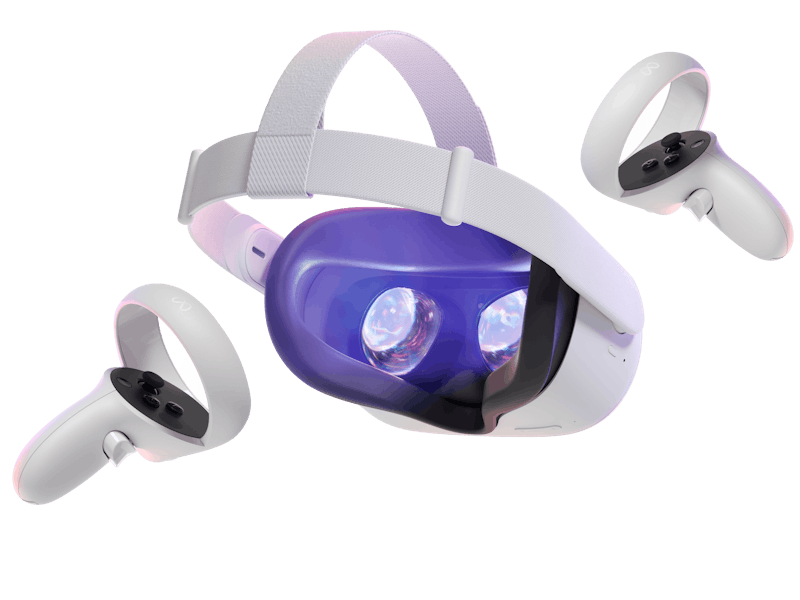Everything You Need to Know About Meta’s Quest 3
Leaked renders show that Meta is working on a successor to the wildly popular Quest 2 VR headset.

There’s finally some word about a true successor to the most popular headset for VR gaming. Thanks to CAD renders from tech YouTuber Brad Lynch and a leak of Meta’s entire upcoming hardware roadmap from The Verge, we now have a pretty good sense of the highly-anticipated follow-up to Meta’s Quest 2 VR headset, which we’re betting will be called the Quest 3.
We’ve reviewed the Quest Pro headset and got an idea of how Meta’s attempts to create hardware aimed at professional use and mixed-reality applications can go wrong. However, news of the Quest 3 means that Meta isn’t ready to give up its position as the top option for casual consumers. Here’s everything we know about the rumored Quest 3 headset so far.
WHAT WILL THE QUEST 3 LOOK LIKE?
The Quest 3 doesn’t look dramatically different than the Quest 2.
Lynch dropped a number of renders that show us interior and exterior details for what looks like the next iteration of the Quest headset. These schematics give us a good idea of what the Quest 3 could look like, and it doesn’t seem as though Meta changed much. We should be taking these renders with a grain of salt, but Lynch previously leaked the schematics for the Quest Pro headset, which appear to be accurate when compared to an engineering sample of the nascent headset left in a hotel room.
The Verge additionally reports that the Quest 3 will “be two times thinner,” though it doesn’t seem as radically slim as the Quest Pro or HTC Vive XR Elite are based on the renders Lynch supplied. If these details are accurate, it looks like Meta more or less stuck to the same successful formula, which isn’t a bad thing considering the success of the Quest 2.
WILL THE QUEST 3 HAVE FACE AND EYE TRACKING?
Going off the schematics, there doesn’t look to be any internal cameras that can accommodate face and eye tracking. Lynch said in his YouTube video that these capabilities would mean more cameras and higher costs, which clashes with the idea of being a consumer-level VR headset.
Eye and face tracking would really add another level of immersion to the VR experience, but you can’t be mad at Meta for trying to keep the Quest 3 affordable — if that is the case. It also looks like Meta is more interested in offering mixed-reality experiences since the renders show what looks like a passthrough camera and a depth sensor.
WILL THE QUEST 3 HAVE COLOR PASSTHROUGH?
It sounds like Meta will once again try and pitch customers on the utility of mixed reality after its less-than-convincing attempt with the Quest Pro. The Quest 3 will feature improved passthrough cameras for mixed-reality apps and games, according to The Verge. Whether those will enable color passthrough like the Quest Pro isn’t clear, but it seems likely.
The Quest 3 will also apparently debut a new “smart” version of the Guardian system Quest headsets use to keep you from bumping into things. The new smart guardian is designed to make it easier to wear a headset for extended periods, letting you walk “effortlessly” through your home without bumping into things and have a drink without having to remove your headset.
WHAT ARE THE THE QUEST 3’S SPECS?
Considering this recent leak focused on renders, there’s still very little information on what chips the Quest 3 will run. Lynch says in his video that a source claims the Quest 3 will use the currently unannounced Snapdragon XR2 Gen 2 chipset.
A previous data mine from Lynch also showed a potential 2,064 x 2,208 pixels per eye resolution for the Quest 3. It would be a sizable upgrade over Quest 2’s 1,920 x 1,832 pixels per eye resolution if accurate. The schematics also show that Meta is going with pancake lenses for the Quest 3, which should translate to a slimmer and more lightweight headset.
HOW MUCH WILL THE QUEST 3 COST?
The Quest 3’s price tag will be a major make-or-break factor for the planned headset. According to The Verge, Meta will sell the headset for a slightly higher price than the $400 Quest 2, something it’s worried could scare off enthusiasts.
A discounted price is primarily why the Quest 2 was so successful. Its accessible price point made it more approachable, even if Meta eventually raised the base price on the headset. Considering Meta recently just lowered the cost of the formerly $1,500 Quest Pro to $1,000, it seems like the company might be more aware that customers are sensitive to the subsidized model Meta’s used up until this point. However, anything cheaper than Apple’s rumored $3,000 virtual reality hardware is probably a win in Meta’s book.
WHEN WILL THE QUEST 3 BE RELEASED?
Since the Quest Pro was the star of last October’s Connect event, this year’s event should be the Quest 3’s turn, possibly alongside other VR/AR headsets Meta may be working on. For now, though, we at least have a much cheaper Quest Pro to look forward to later in March.
This article was originally published on